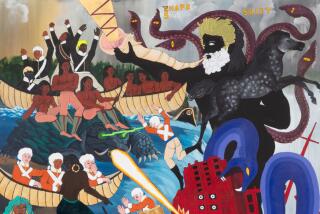La Cienega Area
- Share via
L.A. has grown familiar with the powerful conceptual work of Jeffrey Vallance and his sojourns to Iceland and the island of Tonga in the South Pacific.
Now he presents his second installation of objects and collages made during a visit to the king of Tonga. From Vallance we learn that that 460-pound gentleman and scholar not only rules a happy, orderly island but is a lawyer, anthropologist, surfer and musician. Vallance has also told us that the king’s ancestor, the first king of Tonga, was “the offspring of the God Tangaloa and a common woman born of worms.”
This information typifies Vallance’s entire artistic strategy. His statements--written and visual--are part authentic boyish respect, part sophisticated subversive humor, and Vallance never lets his work resolve itself into either.
The royal throne on view is illustrative. Tonga avoided Western takeover by appropriating British symbols of power: a palace and a monarch dressed in Western regal garb. Vallance packs this ironic information plus much more into his throne reconstruction. As an accurate replica of the actual throne, the embellished antique chair is a visual diary entry. With indigenous tapa cloth and Tonga dye used for the throne’s base, the object becomes a left-handed artifact. As a record of Tonga’s exposure to Western customs, the piece is historical. Finally, with its velvet seat and fake gems, the work is a bit of Disneyland-like kitsch that drums up all our ethnocentric notions about tacky Third World taste.
A surfboard painted with a picture of the surfing king in spotted shorts, his royal staff topped with a Flintstones version of His Highness in Ray Charles shades, a coconut (held sacred by Tongans) carved into a touristy royal portrait, plus handsome collages crammed with drawn, appropriated and photographed imagery also blur distinctions between mythical, historical, intuitive and experienced fact. They hit us with so many levels of meaning that generalizations break down, and that’s what Vallance is after.
Ten excellent drawings fill out the show. “The Seed” (a blossoming pod born from buried debris), “Addams and Evil” (a frenetic Rimbaudian pun on the biblical couple) and large totemic phalluses tap archetypal ideas--order from anarchy, regeneration from decay--that recur in Icelandic, Judeo-Christian, Eastern and native mythologies. (Rosamund Felsen Gallery, 669 N. La Cienega Blvd., to Sept. 2.)
More to Read
The biggest entertainment stories
Get our big stories about Hollywood, film, television, music, arts, culture and more right in your inbox as soon as they publish.
You may occasionally receive promotional content from the Los Angeles Times.










